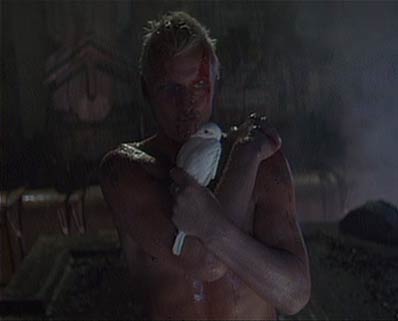Year: 1995
Directed by: Christian Duguay
Written by: Philip K. Dick (story), Dan O’Bannon & Miguel Tejada-Flores (screenplay)
IMDB Reference
Degree of Cyberpunk Visuals: Medium
Correlation to Cyberpunk Themes: Medium
Key Cast Members:
Joe Hendricksson: Peter Weller
Jessica Hanson: Jennifer Rubin
Becker: Roy Dupuis

Overview: Screamers is a low budget near future outer-space movie with some cyberpunk elements in it. We get all powerful corporations and some interesting android/robot self-replicating development. While it has some serious story issues, and doesn’t always have the best acting or FX, there’s still enough here to make it pretty interesting, especially if you’re a fan of RoboCop star, Peter Weller.

The Story: Screamers takes place in a dystopic near future (2078)e environment, where mining colonies on remote planets have been at war with the N.E.B. Corporation for the past 20 years. After a new substance that made space flight possible, called Berynium, was discovered, the N.E.B. Corporation sent out mining teams to the planet “Sirus 68” to mine the Berynium, but unfortunately, it was discovered that the Berynium was accompanied by massive does of radiation. The miners and scientists on the planey Serius 68 revolted, and soon a larger alliance was formed to fight the all-powerful N.E.B. Corporation.
N.E.B. responded by dropping nuclear bombs to kill the alliance soldiers on Serius 68, and then sent in ground troops to finish the job. The alliance responded by developing “screamers.” Screamers are small sentient robots that can burrow underground at a high rate of speed, and then come up and chop humans to mincemeat. The alliance developed a self-sustaining lab that allowed the robots to self-replicate and included learning algorithms to improve their attack capability. The alliance also included an identification beacon so that the screamers would not attack alliance soldiers. Unfortunately, the screamers have begun to learn, so much so that they have started developing their own models, and worse, have started to disregard the identification beacon.
Commander Joe Hendrickson, who has been on Serius 68 since the beginning of the conflict figures out that the war has forgotten Serius 68, and has decided to try to visit the commander of the N.E.B. forces in order to make a ceasefire. Unfortunately, as he discovers in his trek, the N.E.B. forces are the least of his concerns.
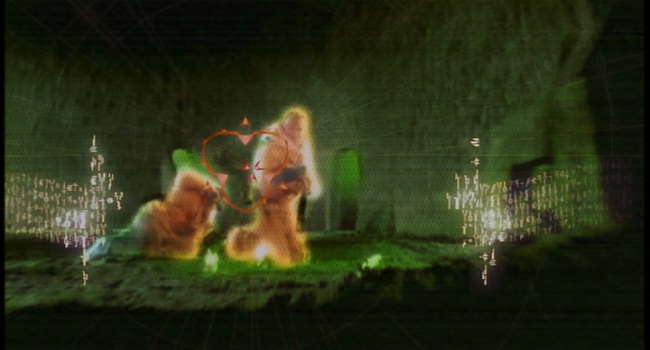
The Visuals: Screamers is a cross between Alien inside visuals and a desert-like Road-Warrior setting (without the punk stuff), or perhaps better said, a Pitch Black setting. Orange is the color du jour. In general, the look and feel of the internal set designs are far less realistic than the outside world. Some of the inside sets would look right at home on a sci-fi TV series. The creatures are pretty low budget too.
The Believability Factor: Although originally based on a Philip K. Dick short story, there are enough problems with the story here that cause you to pause. In addition to some real whoppers regarding the overall plot (for instance, if humans could build adaptive learning robots, why didn’t they just get the robots to mine the radio-active Berynium?), and some serious acting issues on the part of some of the minor characters. Still, both Peter Weller (RoboCop) and Jennifer Rubin are good enough to make this worth watching. More so, the evolution of the robots, while often “magical,” is done at least well enough to make you take pause and actually have a deep thought or two about it.
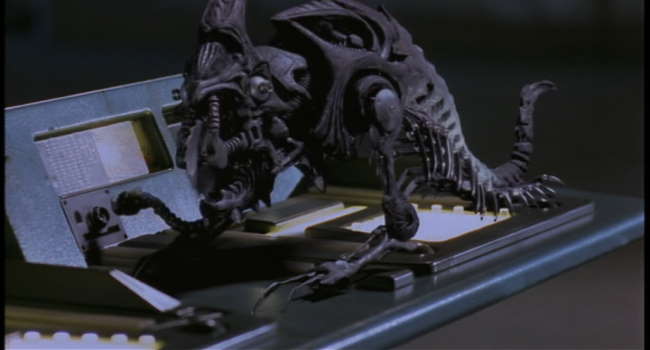
The Bottom Line: I’m really torn in deciding whether to give Screamers a 5 or a 6 star rating. This is not a great movie, but there’s just enough here to make watching it worthwhile. If you’re in to dystopic futures, especially ones involving outer space, you’ll probably want to see this. If you’re in to developing AI type movies, this also should hold interest for you. In terms of “cyberpunkness,” the same thing applies – there’s just enough here to include it as watchable cyberpunk, although you’d be find just calling this a space-sci-fi movie.
~See movies similar to this one~
Tags: cyberpunk movie review Screamers
Year: 1994
Directed by: John Murlowski
Written by: Patrick Highsmith (story), Susan Lambert & Patrick Highsmith (screenplay)
IMDB Reference
Degree of Cyberpunk Visuals: Low
Correlation to Cyberpunk Themes: Low
Key Cast Members:
- J269: Olivier Gruner
- Nora Rochester: Daphne Ashbrook
 
Overview: While some might argue that Nemesis is a better film, I actually like “B” action movie master Olivier Gruner’s performance in Automatic better. Automatic has Gruner starring as J269, a “J Series Automatic” cyborg who’s job it is to protect human life, and most importantly, employees of the RobGen corporation. During the course of his duties, he encounters a RobGen senior manager attempting to rape Ms. Nora Rochester (played by Daphne Ashbrook). In preventing the attack, he ends up accidentally killing the RobGen manager. Not only does killing a human this unlock his freewill, it causes the Goddard Marx, the founder of RobGen to try to kill him and Ms. Rochester in order to cover up the fact that an “Automatic” killed a human.
The Bottom Line: As with many low-budget derivatives, there is nothing truly new storywise here. Unfortunately, I only have a VHS tape of this, so I can’t give you screencaps, but there’s nothing new visually here either. Eventually Automatic turns into a cyborg version of Die Hard. But Gruner plays 4 separate roles pretty well; the action is good, and the FX are just believable enough to keep this interesting. And the twist at the end provides a nice solid ending.
Year: 1995
Directed by: Mikio Hirota
Written by: Mikio Hirota
Degree of Cyberpunk Visuals: Low
Correlation to Cyberpunk Themes: Low
Key Cast Members:
The Terminatrix: Kei Mizutani

Overview: In pursuit of me desire to see all cyberpunk-like films out, I was seduced into getting this flick. Terminatrix is basically the original terminator movie remade with in naked Japanese chicks. In Terminatrix’s vision of the future, an evil artificial intelligence has taken over the human race, and sex is fully regulated to stop overpopulation. But one woman, seeing the injustice in this system, rebels (This is the John Conner stand-in) and starts the resistance by convincing everyone to have massive orgies of their own free choosing. To stop this, the AI sends a hot Japanese cyborg chick - the Terminatrix, played by Japanese Exploitation Queen Kei Mizutani, back in time to have find the father of the chick who leads the orgy resistance. The Terminatrix has the ability to make people impotent by fucking them and breaking their dicks off (this also seems to kill them as well). To find our future heroine’s father, the Terminatrix doesn’t know his middle name, so, um, she goes through the phone book in order to kill the male Sarah Conner stand-in. In an attempt to stop this foul plot, the resistance is able to send a single hot naked human chick (Reece’s replacement - I must say, she looks a lot better than Reece!) is sent back to stop her and to save the father (Sarah Conner substitute). Our Reece substitute can tell who Terminatrix is by checking out her ass, so she is forced to go around lifting up all the women’s skirts!
Yes, this plot is as cheesy as they come, but let me be clear about this - Terminatrix is a frickin RIOT!!! Why, you ask? On an extremely twisted level, Terminatrix so closely follows the Terminator story that you’re continually busting out in laughter. On top of this, both the writing and production values are far above what you’d normally expect from a movie such as this. Literally, if you’re as familiar with that movie as I am, and have a soft spot for over-the-top cheesefests, you will LOVE this movie.
The terminatrix’s cyborg vision lines are a riot. When having sex (they don’t get explicit here, just frontal nudity) with her victems, the Terminatrix’s “terminator screen” messages show things like, “Not cuming fast enough” or “Whip him.”. When the Reece chick finds the future father, she says, “The future of humanity depends on your penis!” At least he has the good sense to shut the door on her. Also, if Terminatrix’s future prognostication is any guide, the future is tailor-made for male chauvinists. In this “dystopia,” a computer calls you to have sex with random chicks - but here’s the bad part - you have to lay down while they to all the work! Hmm…come to think of it, I can probably imagine worse computer-dominated future scenarios than the one that prompted the revolution.
Funniest scene Hands down, the bathroom cyborg self-repair scene is a riot! You know the one I’m talking about - where Arnold has to fix up his face and stuff? In this version, the Terminatrix has been shot six times in her primary weapon (her vagina), and has to repair it. While rolling her eyes, she forces six bullets to come out of her vagina (they don’t show this other than by the dropping of bullets), then she recharges herself by putting electricity through her nipples. To make final repairs, she fixes herself down below by sitting on a mechanical dildo! In watching this, all you can say is “My God, what a bizarre flick!”
It Matters Where you Purchase This: IMDB doesn’t even have a listing for Terminatrix, so one would think its not easy to come by. At the time of this review, you can purchase it for $27 bucks at Amazon. While funny, $27 bucks is about least $18-20 more than you would want to pay for something like this. But you’re in luck as Deepdvddiscount has it for $5.99! That’s about as large a jump as I’ve seen in available DVD prices.
The Bottom Line Again, I’m rather shocked that Terminatrix has relatively decent production values. The acting isn’t bad either, so much so that it’s like they made a serious attempt at this! I didn’t attempt the dubbing track (I almost never do), but I’m guessing it’s something to stear away from. All in all, Terminatrix is a very fun entry into the cyberpunk (facade) soft-core porn market. And while this clearly isn’t cyberpunk, it is definitely a cyberpunk parody (of the Terminator). Fair warning - this movie will make you laugh out loud - it will not get you in the “mood.”
And my apologies for the lack of screencaps. I honestly tried to take screencaps but it was a waste of time, as all the cool scenes had nudity in them.
~See movies similar to this one~
Tags: cyberpunk movie review Terminatrix
Year: 1994
Directed by: Hiroyuki Ochi
Written by: Akinori Endo, Chiaki Konaka
IMDB Reference
Degree of Cyberpunk Visuals: High
Correlation to Cyberpunk Themes: Very High
Key Cast Members:
Armitage: Hiroko Kasahara
Ross Sylibus: Yasunori Masutani
D’Anclaude: Ryûsei Nakao
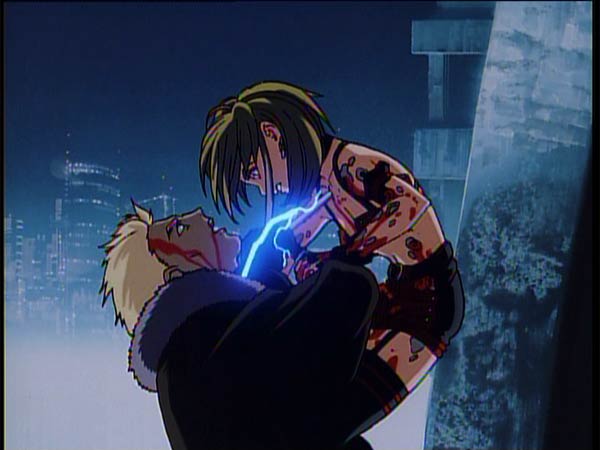
Overview: Armitage III, one of the many Chiaka Konaka written masterpieces (along with Serial Experiments Lain, Texhnolyze, Malice@Doll) is simply an awesome story. If you like Blade Runner and haven’t seen Armitage, you’re doing yourself a disservice. Most of the same issues are raised there, but are done in an original enough way that makes you absolutely love this little anime chick. Humanity as an exclusionary concept which also implies “worth” is fully explored here. Are androids still supposed to just be our servants even if they do have a sense of self-worth?
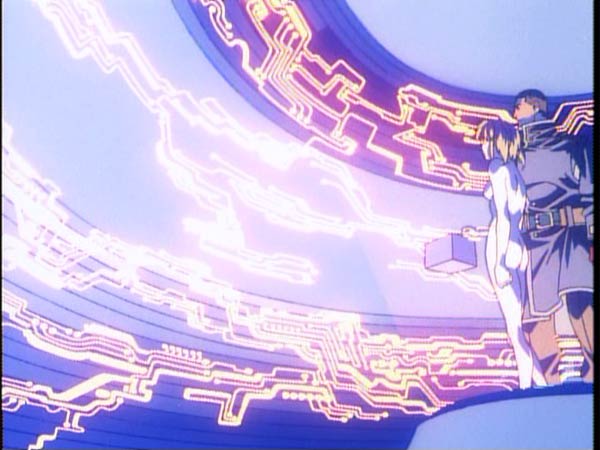
Set in a Blade Runner-like future, mostly centering on Mars, Naomi Armitage is a type III series android who works as a cop on Mars, along with her new partner, Ross Sylibus. While most of the public knows about, and barely tolerates the type II series, they are not aware that there are a few lifelike, human-acting type III series androids living among them. Unfortunately for the robots though, someone knows of their existence and is systematically killing them one by one.
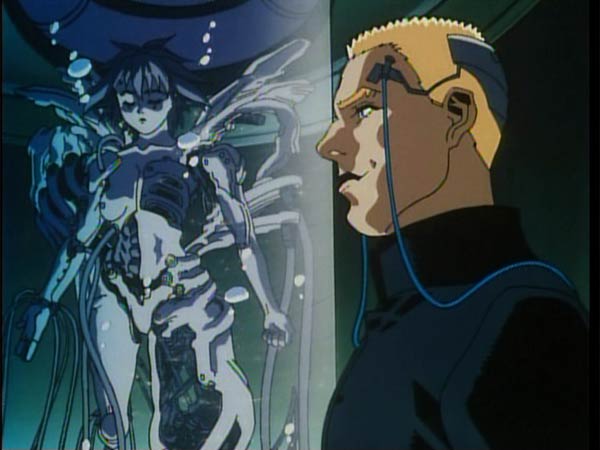
As the plot progresses, Ross, who doesn’t like robots (his former partner was killed by a cyborg) learns that Armitage is an android. Even worse, they learn that the murderer is a series IV robot. Armitage, who starts off as a wise-cracking, disrespectful cop who dresses in sleazy clothes starts to question her “humanity” such as it is. In addition to realizing she’s one of the very few left, Armitage wonders why she was ever created. As she struggles to maintain “sanity,” Ross begin to develop a closer relationship - one that is not too mushy, and works well with the pacing.

Armitage eventually broadens into a large-scale conflict that involves greedy corporations, inter-galactic disputes, android’s rights, population issues, and all the rest. We get LOTS of gun fights in this, and even a full scale battle, mecha style. In addition to being cute and vulnerable as an android wondering if she has a purpose in life, Armitage also kicks major ass in her burgundy leather ensemble. Guts, martial arts and all sorts of other gadgets come flying out of this chick. She is definitely, tough, strong willed, and lots of fun to watch.
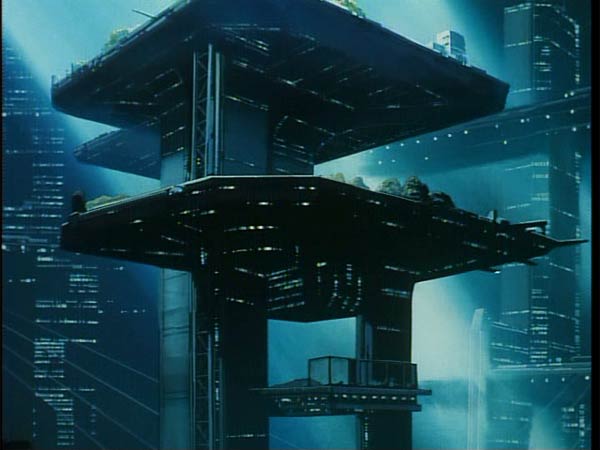
Notice the incredible similarity to another futuristic building in Metropolis.
The story is one of the most compelling in cyberpunk anime and really makes you feel for Armitage. Yes, the whole questioning of humanity by an android has been done before (and since) and since, but Armitage is definitely one of the better ones at this. Within the confines of a murder investigation, Armitage’s “soul” is exposed in her search for larger meaning and purpose, all while her fledgling relationship with a cyborg-hating policeman begins to emerge. Interesting questions are posed such as, what happens if an android has a fatal flaw? Should we throw them away is if they are they truly nothing more than a toaster? This is in essence a mirror to questioning how we deal with handicapped people in human society. We still consider handicapped people valuable and contributing members to society, but would we do the same with disabled Androids? At what point do they become real as opposed to simply remaining property - a tool for humanity?

The Bottom Line: The visuals and sounds in Armitage III, while good, are somewhat dated and inconsistent. Some shots are absolutely superb, while others have a relatively plain background and almost 80s looking characters. Overall, there’s enough there to keep your interest, but its the story that delivers. Truly, I absolutely LOVE it!
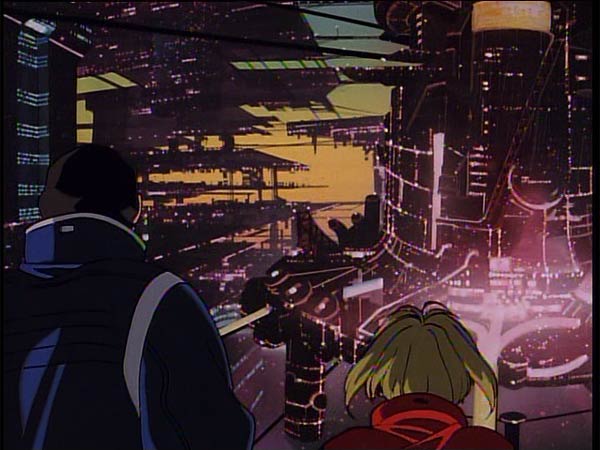
What is Armitage III Polymatrix? Polymatrix is a movie extracted from the 4 OAVs in Armitage III. While it is missing a few interesting scenes, its still watchable. It also has Kieffer Sutherland and Elizabeth Berkley as voice actors here, so if you can’t stand subtitles (You really fix this problem in the long run though), Polymatrix is a reasonable substitute. Some truly hate it primarily due to the English dubbing, the missing scenes and the changed ending. For me, I was OK with the dubbing, was generally OK with the scenes missing, but I liked the ending in the OAV (this movie) better.
~See movies similar to this one~
Year: 2000
Directed by: Shu Lea Cheang
Written by: Shu Lea Cheang
IMDB Reference
Degree of Cyberpunk Visuals: High
Correlation to Cyberpunk Themes: Medium
Key Cast Members:
Tokyo Rose: Aja

Overview: If you’ve been hankerin for a nice quality ultra-surrealistic medium-core porn Japanese cyberpunk flick, then look no further than I.K.U. Japanese cyberpunk movies are all about no boundaries and I.K.U. takes this notion to heart, coming up high on the wierd shitometer scale. For the soft-core goods, you get a bit of everything here: guy-on-girl, guy-on-guy, girl-on-girl, girl-on-transgender, voyeuristic sex through a fish tank while eating sushi, sex in a spider-web…well, you get the idea. And while if what you’re looking for is naked body parts, I.K.U. definitely delivers (some cases its pixelated out, but in most cases its definitely NOT pixelated out, even when you wish it was…). Fair warning though - this is NOT a “take care of yourself” type movie, as you will spend most of the time dumbfounded while watching it. I.K.U is an EXTREMELY strange, but well-done mind-fuck, pure and simple.

I.K.U. takes place in a very strange near-future Japan and follows a day in the life of a sex-roid from the GENOM corporation, who has the ability to change her outside shape to mimic different female body types. Her job is to collect “sexual experiences” by engaging in sexual acts with various people. The experiences are collected in order to produce virtual reality-like I.K.U. chips that are then sold in vending machines. The idea is that people can buy the chips and then “wire in” on the sexual encounter. Unfortunately, a rival corporation has developed rival androids who’s job is to insert a virus into the sex-droids and steal their “experiences” so that it can make its own rival chips.
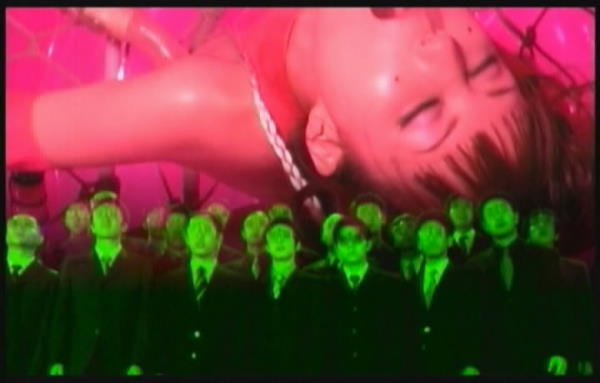
But truly, the story is not the reason you get this. In fact, the visuals distract you so much from the story that I strong recommend reading the story bits on the extras prior to watching this film. The reason you watch this is for the extremely weird but interesting set designs and cinematography. Every “vignette” offers some truly interesting cyberpunk visuals. Shocking neon is the order of the day here. Shocking “you” is the point of the film.
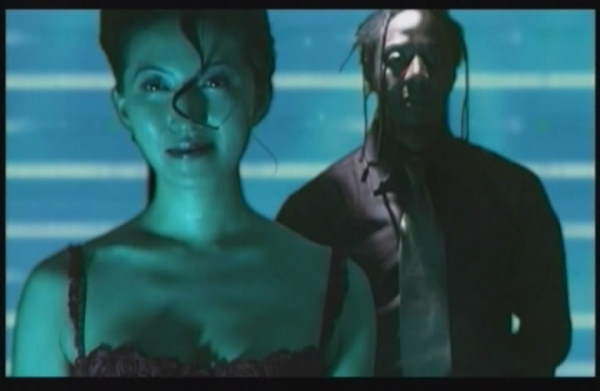
The Bottom Line: If you’re a “no boundaries” kind of film watcher, and are interested in something WAY off the beaten path, give I.K.U. a try. Just to be clear, I.K.U. opened at the Sundance Film Festival, so again, this is not your average skin flick - this is an artsy skin flick. And honestly, rating this film is a complete waste of time, as I really have nothing to compare it to (I’m giving it a 6, just because…).
PS - one word of caution - the guy-on-guy oral sex scene is one that is NOT pixelated out, nor is the scene with the transgender (I think that’s what he is…a guy with an “in-between” part). Both only last for a few seconds or two, but are QUITE graphic if you get my drift…

Again, I could go on, but truly, commentary is a waste of time on a flick like this. What you need to evaluate whether you want to see this or not are screen captures. On to Page 2 of this review if you are so inclined. Fair warning - while I worked hard not to show any body parts, page 2 is clearly meant for adults.
Page 2: Screencaps–>>
~See movies similar to this one~
Year: 1997
Directed by: Albert Pyun
Written by: Albert Pyun, Ed Naha
IMDB Reference
Degree of Cyberpunk Visuals: Low
Correlation to Cyberpunk Themes: Medium
Key Cast Members:
Rating: 5 out of 10

Overview: In this strange apocalyptic tale, most all the humans have died out and now two different groups of androids spend their time killing one another. Unfortunately it appears as if the humans are returning, so they need to find weapons to protect themselves. In one western town, these two groups have reached a stalemate while looking for a hidden “treasure” stash of guns and ammo. Along comes the lone warrior, Bruce Willis (Last Man Standing), er, I mean Clint Eastwood (Fistfull of Dollars), er, I mean Toshirô Mifune (Yojimbo), er, I mean Rutger Hauer - only this time he’s a cross-over android with parts from both rival robot types. Did I mention that he’s fast with his whatever the fuck that gun-looking thing is at his side?
If you know any of these movies, you know the plot here. Some parts are done decently, but others could really be improved. In any event, Omega Doom wins on low-budget style points while it loses out on about 10 minutes of missing explanations. Why do the androids need water? Why do they breath air? Why do they both fear death but seem to be forced to follow their programming? More importantly, why can androids ignore their programming when their emotions are heightened in key scenes? Is this the same reason that my computer uses to crap out when I’m under an intense deadline?
The Bottom Line: Not a high quality picture, but maybe not quite as bad as others are saying. There are some interesting fighting scenes, and I find western cyborg films appealing. And truly, for as low budget as this movie was, Pyun produced at least a semi-watchable product.
Year: 2003
Directed by: Byung-chun Min
Written by: Byung-chun Min
IMDB Reference
Degree of Cyberpunk Visuals: Very High
Correlation to Cyberpunk Themes: Very High
Key Cast Members:
R: Ji-tae Yu
Ria: Rin Seo
Cyon: Jae-un Lee
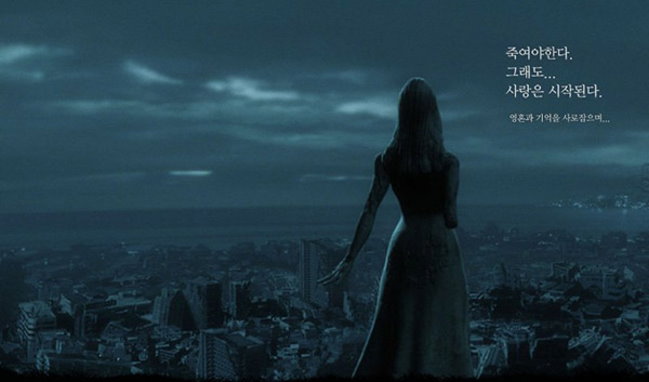
Overview: Natural City is a high priced attempt by the Korean movie industry to break into the Scifi Genre. The quality of the effects in Natural City clearly shine, both in the absolutely terrific set pieces, the painted backgrounds and the very realistic future setting. This is a cyberpunk movie to its core, with every possible aspect of cyberpunkness oozing from every pore of this movie. We get cyborgs, genetically engineered and cybernetically enhanced people, dominating corporations, theft and greed, seedy underground people and scenes, information access issues, and MASSIVE cyberpunk style. But truly, the reason Natural City rates this high is the absolutely wonderful cyborg character study in exploring issues of humanity.

The Setting: Natural City as a title is 180 degrees from what you get in a setting - nothing is real here. In this dystopian setting, genetic engineering and cyborg development have become an accepted way of life. Pretty much everyone in this city lives a miserable existence, in fact, its expected that life is pain. Vacations are taken in the equivalent of a Star Trek Holodeck type machine. The ultimate dream of everyone in this city is to become rich enough to retire to a floating hotel called Muyoga (see the picture immediately below), which advertises that it can erase your current memory and place you in a "virtual" life of your own choosing. This is extremely interesting, especially when compared to Oshii’s Avalon, in which one view of the the "ultimate" life is one where you are in a simulated reality of your own mind even though your body is a slobbering mess in the "real" world.
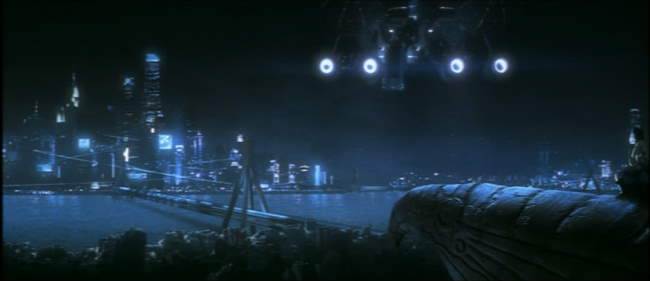
In Natural City, Cyborgs perform a myriad of societal functions - everything from entertainment and dancing, to restaurant helpers to working on the police force. To perform all these functions effectively, Cyborgs have a degree of self-awareness. This causes significant complications when their expiration date nears, as they know what it means to "expire." While some of the characteristics seem vaguely familiar to another far more famous cyberpunk movie (cyborgs with expiration dates, for instance), the story itself is radically different.
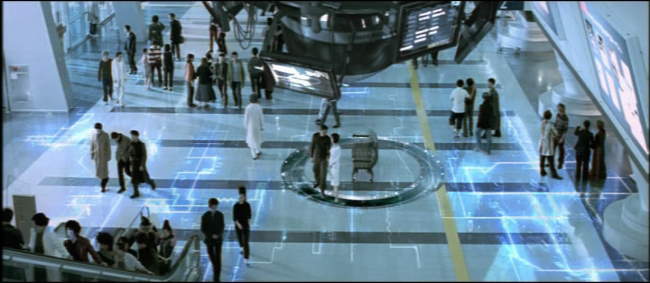
The Story: Natural City centers on the internal struggles of a highly talented cop named "R." He is tasked with finding and capturing renegade cyborgs, but ends up falling in love with a cyborg dancer named Ria who’s expiration date is only 3 days off. The movie centers on R’s compromising his principles and dealing with the cyborg underworld in a vain attempt to find a way to save his Ria. He finds a shady cyborg doctor who promises that if he finds a person with the right genetic match, he can inject part of their brain cells into Ria, which will save her. The doctor finds such a match in a street girl named Cyon.
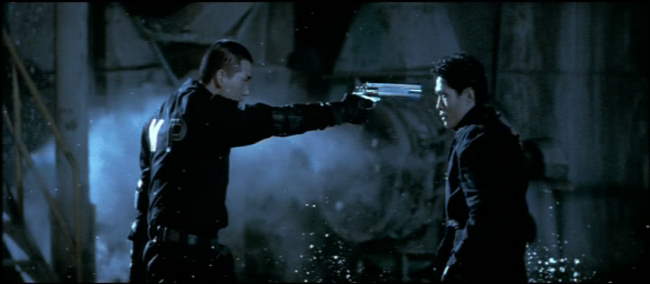
Complicating matters, R’s best friend Croy, who is also his boss and fellow police detective, has discovered his duplicity. During a raid to capture some renegade warrior cyborgs, Croy notices that R is not shooting them in the head (which kills them be wiping out their AI chip), but is instead going back later and collecting the AI chips to sell for money. Croy tracks R back to the shady doctor. Worse, one of the warrior cyborgs who escaped is also after Cyon for reasons that become all too apparent as the movie unwinds.
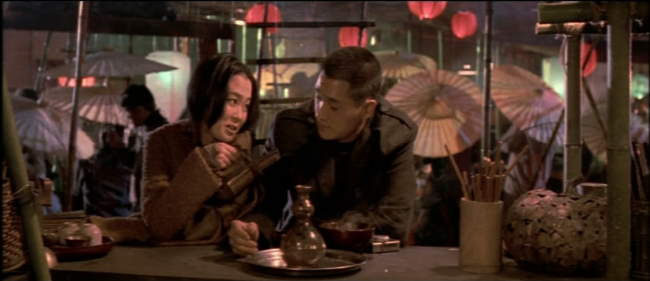
The Look: Natural City’s atmosphere is a grimy, lived-in futuristic environment. In some of the police scenes, Natural City comes across like a live-action Jin Roh movie (Jin Roh is definitely an influence for the action visuals). The high-quality and very original Scifi set pieces and occasional CG fits wonderfully, and along with the artistic backgrounds add up to a very immersive experience. The surround sound is not stunning, but is certainly decent and doesn’t detract from the experience. On top of this we get some wonderfully symbolic visuals, such as when Cyon sits atop a stone eagle statue, dreaming of life on the virtual hotel.
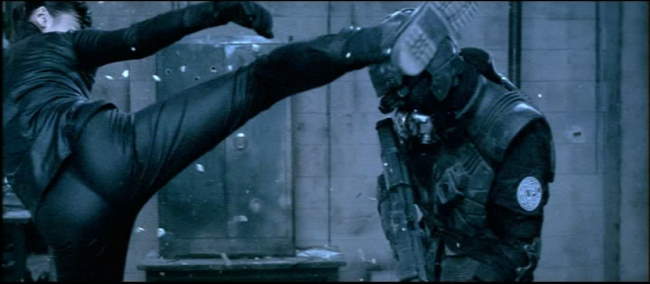
The Colors: Like most cyberpunk movies, Natural City uses one dominating color palette for the majority of the scenes. Blue is the color of choice, but varies from ultra-light to dark and dense blues. The lighter scenes usually depict high-tech human aspirations, whereas the darker scenes are left for massive action shots and for shots depicting the destruction of humanity, such as the gritty cyborg replacement lab. Every so often, we also get some really nice oranges and browns, but these colors are usually used more as chapter transitions.
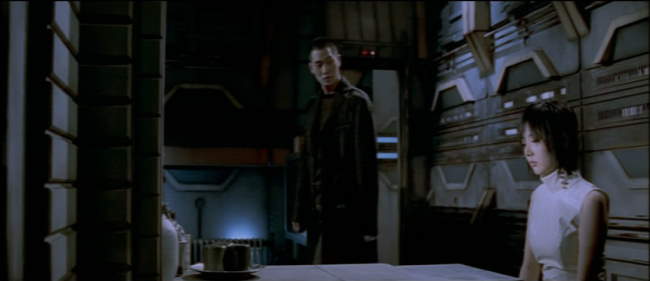
The Action: Natural City is a character exploration first, but the action and effects are on display, and in high quality. The action involves both slo-mo and high speed camera shots, along with LOTS and LOTS of blood and gore. The ending especially is somewhat of a gorefest, which is weird to see in a movie that is mostly a drama in nature. Also, near the end of the movie, we get treated to an evil, but ultra-hot cyborg warrior chick in skin tight lycra who engages in some major ass-kicking (see above for a pic of HER ass while kicking someone!). Talk about a plus! While we’re on the subject, we also get treated to some cute asian cyborg boobies at the beginning of Natural City - definitely a nice way to start the pic! (although, when you understand what the beginning boobie scene signifies it sorta takes away the fun).
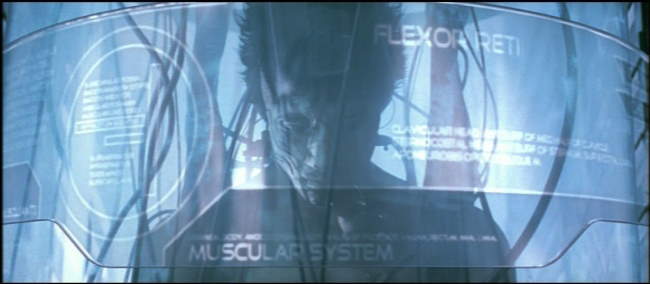
The Pacing: As I mentioned earlier, this IS a Korean movie. My wife is Korean, so I’m somewhat used to the pacing we see here. From reading a few reviews, Natural City has been panned for being way too slow and plodding in the middle. All I can say is, "Welcome to Korean Cinema." This is really a case where story telling is just different there. For a Korean, this movie is not at all slow, but has rather standard pacing, which means we get REAL in-depth and repeated scenes with the purpose of mood and detailed character study. Most important for Koreans is to be able to identify with the emotion and mood the characters are experiencing. Natural City takes the time to do this with all the main characters.

The characters really build in believability and engagement as the story progresses. At the beginning, R appears quite shallow, as does his friend and the street girl Cyon. By the end, all three, and especially Ria, his cyborg lover grow to be characters you really empathize with. The motivations for all become clear, including their virtues and flaws. The ending is also a rather "normal" Korean dramatic love story ending, which is to say, one very different from how an American film might end. Its not a feel-good movie, but then again, few Korean dramas are.

For me, the highlight of Natural City centered on Ria, the cyborg. To me, Ria captures the cyborg struggle for humanity better than any character in all cyberpunk movies save one scene (the Blade Runner’ sRoy Batty "I’ve seen things you wouldn’t believe" soliloquy, of course). While I didn’t catch this the first time through, the very beginning of the movie is told from Ria’s perspective, and then really, the last third of the movie centers on Ria (minus the action sub-plots). There are a few scenes that make it clear she "knows" what’s happening to her. She is programmed to be a dancer, but as she reaches her expiration date, she no longer can do this well. In one scene, Cyon shows her the "1 day" notice that arrives in the "Fifth Element" style mail slot. As her "time" approaches, you really do get the feeling of the Rutger Hauer speech at the end of Blade Runner, although Ria conveys this sentiment more broadly over a number of scenes and images. I want to go into this further, but this starts coming off as a spoiler, so I’ve added a more elaborative discussion of Ria’s motivations (spoilers) after the screencaps on Page 2.
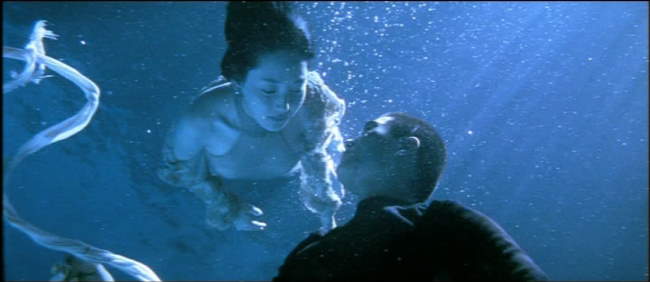
The Bottom Line: If you like cyberpunk films, the visuals alone make this a MUST SEE. If you like character studies in science fiction settings, you probably also want to see this. I truly LOVE Natural City, but be warned, the pacing is different from what you might expect. This is a Korean movie, and certainly plays like one. Also, be warned - like Wonderful Days, the ending has standard Korean Melodrama type stuff. While some might argue this doesn’t belong in the top 10, for me there’s no doubt that it does. The action and visuals are great, but Ria’s story clearly forces it there if nothing else.
Page 2: More Screen Caps and Ria’s Motivations Discussion (Spoiler)–>>
~See movies similar to this one~
Tags: cyberpunk movie review
Year: 2000
Directed by: Keitarou Motonaga
Written by: Chiaki Konaka
IMDB Reference
Degree of Cyberpunk Visuals: High
Correlation to Cyberpunk Themes: Medium
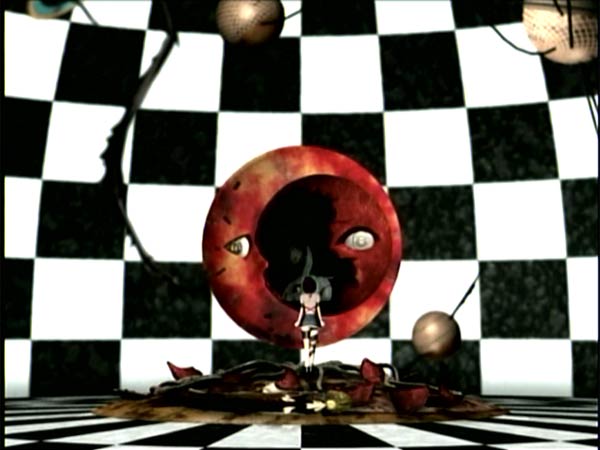
Overview: If you haven’t figured out by now that I have a soft spot for surrealist cyberpunk films, you will after this review. Malice doll is a terrific low-budget surrealist cyberpunk anime that takes place in an unspecified future, after all of mankind has been eradicated. This surrealist cyberpunk version of a pinocchio story focuses on a group of sex andriods called dolls (not unlike GITS2) living in their whore house who now simply drift through existence without any purpose. One Doll, Mallice, while exploring, encounters this strange tentacled beast who “rapes” her with about 40 tentacles (while one goes between her legs, the rest rip into her pretty much everywhere - this isn’t meant as an erotic scene, at least I don’t think so) and ends up transforming Mallice into a human. Malice then shares her “gift” by kissing all the other dolls and robots.
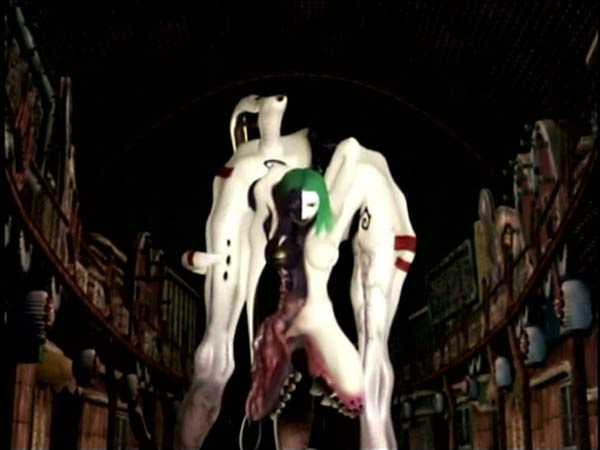
Malice@Doll is a very deep movie and traces some rather interesting notions. For instance, It challenges the notion that a doll made in man’s image, if given the chance, would choose to become a living organism that looked human - maybe they would choose something completely and utterly different. Simultaneasly, this anime also asks if you would be how you really see yourself, what would you really look like?
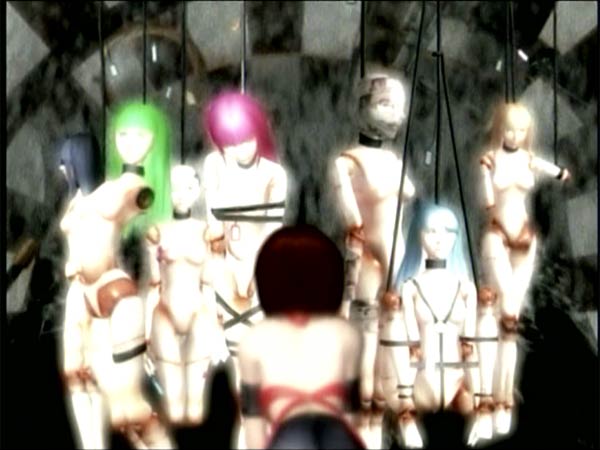
Malice@Doll virtually disappeared almost as soon as it opened for a couple of reasons. First off, it came right on the heels of Final Fantasy, a blockbuster anime. While its wonderfully shot, the animation quality simply doesn’t compare with the high budget 3D movies. Also, Malice@Doll is another one of those films that’s simply too wierd for most people, and ends up being categorized as everything from Hentai on down. Truly, this anime is two scenes removed from being a PG anime, and certainly wouldn’t qualify for anything past R. I happen to love it LOTS more than Final Fantasy though.

The DVD Extras: Another reason you want to buy this DVD is for its terrific extras. These include a college film class presentation on digital animation from Jonathan Clements - Co-Author of the Anime Encyclopedia. This is flat out terrific. In addition to tracing the change in Japan from cell animation to 3D animation (and the effects this had on the industry), Clements shows how Malice@Doll is one of those films that actually uses story elements to turn its technical weaknesses into strengths.
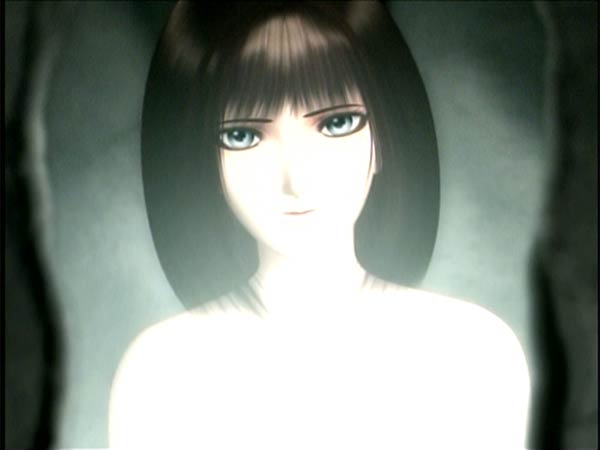
For instance, although their capalities for doing high quality stills are there, Motonaga didn’t have the equipment to do fluid movement. He solved this with a “story” solution - he made the movie about android dolls, who are SUPPOSED to be jerky in their movements. For the “human” scenes, they used cell animation as highlights - this makes for a striking difference in the animation (See shot above).
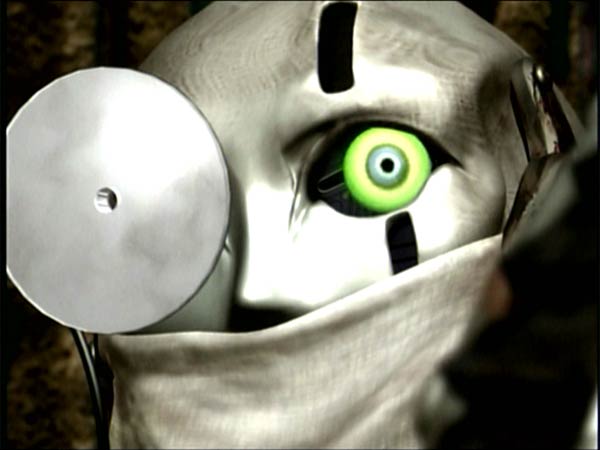
The Bottom Line: Truly, aside from the surrealist story, the reason to watch this is for the visuals. A lot of the visuals in Malice@Doll almost remind you of a Salvador Dali painting. The diversity is such that I could have taken about 40 completely different screencaps here. BTW, while Amazon sells this for 22 bucks, Deepdiscountdvd sells it for $14.
~See movies similar to this one~
Tags: cyberpunk movie review anime
Year: 1982
Directed by: Ridley Scott
Written by: Philip K. Dick (Novel), Hampton Fancher & David Peoples
IMDB Reference
Degree of Cyberpunk Visuals: Very High
Correlation to Cyberpunk Themes: Very High
Key Cast Members:
Rick Deckard: Harrison Ford
Roy Batty: Rutger Hauer
Rachael: Sean Young
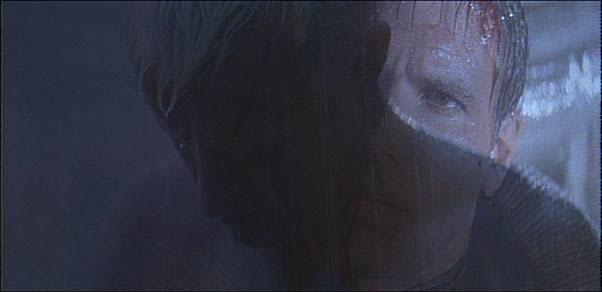
I’ve seen things you people wouldn’t believe. Attack ships on fire off the shoulder of Orion. I watched C-beams glitter in the dark near the Tannhauser gate. All those moments will be lost in time, like tears in rain. Time to die…
Overview: If you read a lot of the reviews from others about movies on this site, you’ll find that over half of them reference Blade Runner in some way, other in the visuals or issues discussed. Along with Gibson’s Neuromancer, Blade Runner did more to establish cyberpunk as a genre. The fact that Blade Runner came two years prior to Neuromancer is rather interesting. Truly, this film set the standard for the near-future film noirs sub-genre we call cyberpunk.
Not too dissimilar to the wrath that greeted Metropolis’ release, Blade Runner was not an instant hit. Instead it grew from being critically panned to a cult classic, to now, where its well on its way to being considered a timeless classic.
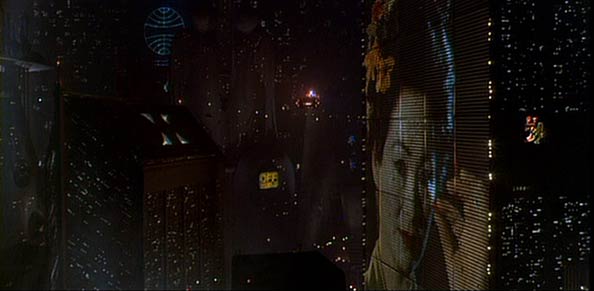
Commerce is our goal here at Tyrell. More human than human is our motto
The Visuals: The visuals in Blade Runner are simply stunning. We see corporate pharaohs ruling a society containing manufactured slaves from their Egyptian style pyramids, while we see rot and decay on the streets below. Noir-style beige and blacks dominate the screen, but are often supplanted by shocking neons. In Blade Runner, we see and Earth in ruin - a place that people are eager to leave. Only the poor and problematic are left on this rain-soaked dystopian planet that has been raped of any semblance of natural existence. The Earth is now almost completely devoid of trees and animals, which are now replaced with artificial ones for the pleasure of mankind.
The Story: Technology and corporate power are clearly the cause for this downfall. Genetic engineering has run rampant, and is combined with advanced organic computing technologies. It is in this world that we find a cast of flawed characters. Nobody is pure, nobody pristine. They are all a product of the environment they live in.
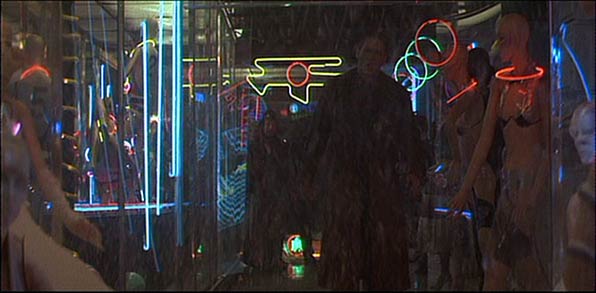
Replicants are like any other machine - they’re either a benefit or a hazard. If they’re a benefit, it’s not my problem.
To augment humanity’s needs and desires, replicants, or genetically engineered humans imbued with artificial intelligence have been developed. They serve many important roles including protection, pleasure slaves, and hard labor for the most dangerous environments. While replicants start out as rather straightforward and useful machines, over time, they start to develop awareness - their own personality, and eventually, free will and a desire for self-preservation. Because they are defined as property, Replicants are given a 4-year lifespan, which is enforced upon inception, and is irreversible.
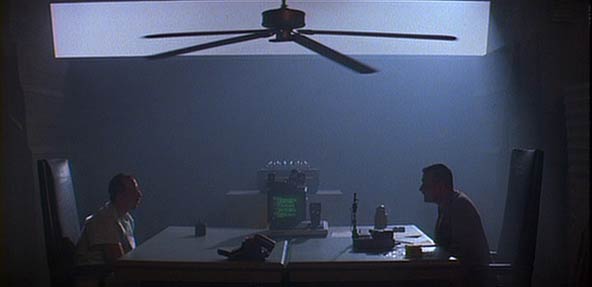
My mother? Let me tell you about my mother!
It is in this world that we encounter Deckard (Harrison Ford), a Blade Runner. Blade Runners are cops who hunt down Replicants. At the beginning of the movie, we find that Deckard has supposedly retired from the business.I say supposedly here, because if he is a replicant, then really, he has been imbued with false memories as well, and in fact has never been a blade runner prior to this. Really, he is just filling in as a laborer fulfilling another job that is too dangerous for humans.
Deckard is brought back in to "retire" 4 runaway "skin jobs" (replicants) who have murdered humans off-world and have escaped to Earth. Apparently, they seem to be interested in coming back to their creators - the Tyrell corporation. The story expands from there, and truly touches on some wonderful questions concerning ethical dilemmas that most certainly will arise in the future.
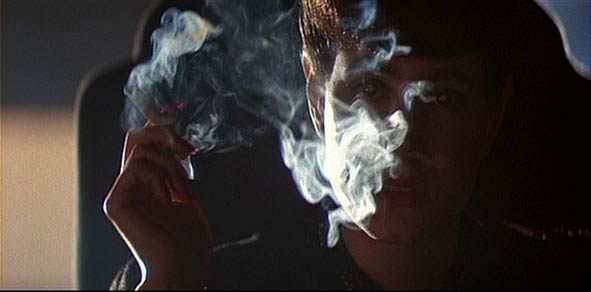
Are these questions testing whether I’m a replicant or a lesbian, Mr. Deckard?
I’m not in the business. I AM the business… Deckard encounters Rachael (played wonderfully by Sean Young), a replicant who during the movie discovers her true nature. Blade Runner does a masterful job of exploring the questions and emotions surrounding this. We see Rachael’s theme echoed in Natural City, Armitage, Thirteenth Floor, Ghost in the Shell, Serial Experiments Lain, Malice@Doll, the Animatrix, I, Robot, and others. This question about what degree artificial life forms are human is a central theme of the cyberpunk genre.
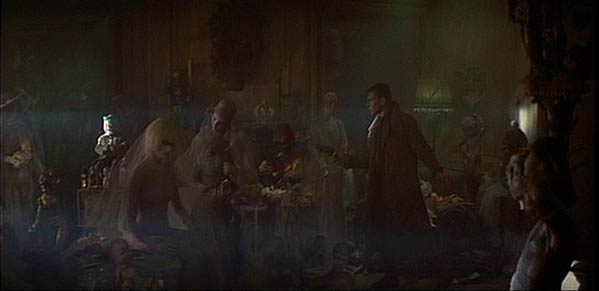
What is Human? While other movies have been terrific in exploring this, Blade Runner still sits at the top of the list, both for Racheal, and for Roy Batty, the leader of the renegade replicants. Roy’s monologue near the end (see the quote at the top), which was supposedly adlibbed by Rutger Hauer, captures in a single moment the ethical dilemma with creating sentient life. If they have freewill, can they really be considered property? And if they aren’t property, what are they, exactly?
Blade Runner uses mannequins and toys as its set piece for representing this dilemma. In Blade Runner, corporations create these glorified toys - moving mannequins if you will, to meet the needs of society, yet while the toys themselves are clearly a product of the society just like all the other noir characters, are they truly nothing more? And if we do consider them to be on par with humans, what obligations do they have to their creators, who invested time and money in their creation?
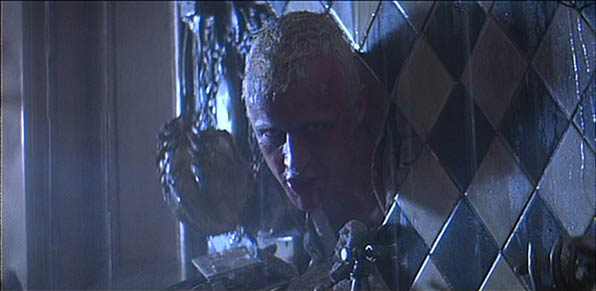
The light that burns twice as bright burns half as long - and you have burned so very, very brightly, Roy.
The Bottom Line: On top of all this philosophical questioning, we get some great noir-detective-like action and suspense. Roy Batty is truly a badass. Deckard’s pursuit of him is a very fun engagement, as is the climax. Its flat out terrific. The pacing is wonderful, the visuals are astounding, and the story is enthralling. By now I’m guessing most have seen this cinematic masterpiece, but if not, you are truly in for feast!
Page 2 - More Screen Captures–>>
~See movies similar to this one~
Tags: cyberpunk movie review
Year: 2004
Directed by: Mamoru Oshii
Written by: Shirow Masamune (Comic), Mamoru Oshii (Screenplay)
IMDB Reference
Degree of Cyberpunk Visuals: Very High
Correlation to Cyberpunk Themes: Very High
Overview: If you’re looking for the best instance of awesome 2D-3D anime with an incredible philosophically laden story, Ghost in the Shell: Innocence is the hands down winner. While I still like Wonderful Days more on pure cinematography, it doesn’t hold a candle on either the story or the philosophy. Oshii is truly a master at providing an incredibly intricate, fully researched message about the direction of humanity in a wonderful anime package. Make no mistake - Oshii is fully up on co-evolution theory (the co-evolution of man and his tools) and has something very interesting to add to the discussion. And while it has all of this, GITS:2 does suffer overtly and purposefully from the absence of its star character - Motoko.
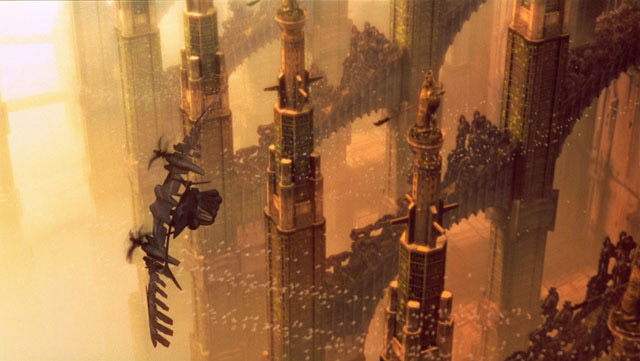
Major Motoko, the main character from the first Ghost in the Shell movie (which might still make an appearance here…) is no longer here, and the rest of the cast has to pick up the pieces and move on. Bateau (Ôtsuk), major motoko’s partner from the first movie, and a cyborg detective for the anti-terrorist unit Public Security Section 9, investigates the case of a female robot - one created solely for sexual pleasure - who slaughtered her owner. Togusa, the mostly human detective that Motoko found in Ghost 1 is assigned as Bateau’s partner. The plot thickens as the movie progresses, and the two are sent to a number of incredibly cyberpunk looking locations to uncover the truth.
Overall, this movie has the feeling of a cast trying to cope when the major star has left. Similar to the Borg Encounter when Picard is removed, or maybe some of the first star trek series when Captain Kirk is lost somewhere doing green chicks, Motoko’s disappearance dominates a most of the back story. We get to see almost a character study of Bateau, a mostly cyborg being who has suffered the loss of the closest person alive to him struggle to maintain meaning in his life
and Togusa failing to live up to Bateau’s expectations as a partner. While the characters are able to work fine within the plot, the movie suffers from the lack of both sex appeal and the lack of a truly dominant character.
Similar to other Oshii films, there are instances where the plot gets put on hold to allow the philosophy to explored. This is a different sort of pacing (again copied by the matrix) which some like and others find pretentious (I like it!). The philosophy breaks are interesting, but only get fully connected at the end. Additionally, the plot is twisting enough and only clarified in the end that a second viewing would aid in comprehension.
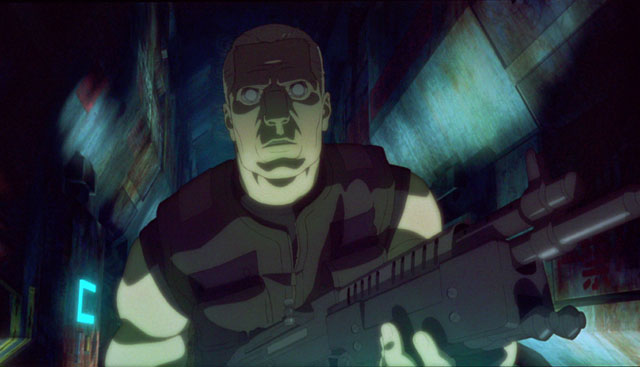
Even if you don’t like the metaphysical mumbo-jumbo or strange pacing, Ghost 2 should be seen as mandatory viewing for its truly mind blowing merging of computer imagery and hand drawn animation artistry. This is cyberpunk at its finest! Truly, Neuromancer’s William Gibson would be floored with the continually awe-inspiring scenery that’s intermixed with the grittiest of settings. I lost count of the number of sets I would have loved to freeze and place on my wall. From the creation of robots complete with fiber optic circuitry and positronic brains, to the dingy alleys of the underworld, the vast expanses of the futuristic building-scapes, this movie employs every color palette in the most effective manner imaginable. Often, you almost stop paying attention to the subtitles to just take in the scene in all its heavenly glory.
On top of this, we get trademark moments of Oshii pacing. Oshii is fully content to leave the dialogue aside for a while and let the mood develop from the visuals and sound. Very few movies do this effectively - Avalon and GITS:2 certainly come to the top of the list. In short, the pacing makes GITS:2 a fully immersive experience in a way that visuals alone couldn’t do.
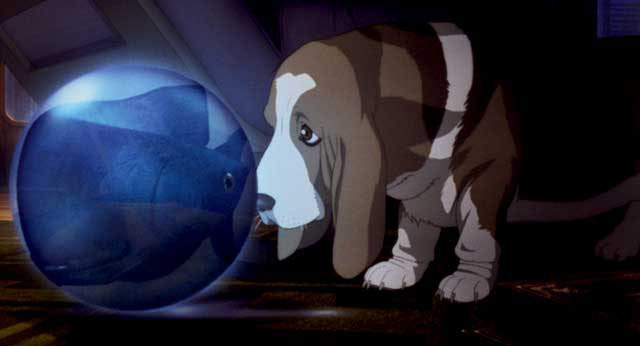
GITS 2 Philosophy: In looking at the philosophy, the first Ghost was dominated by a discussion of what it means to be human and being alive. It culminated in the creation of a new species - the merging of a sentient program called the puppet master with Motoko, an alive human complete with a soul (ghost). Without knowing the details of Ghost 2, one would have expected in seeing the first movie that Oshii would have explored this vast new experience in Ghost 2, Yet this was not to be, as instead the story takes a very different perspective to the ideas covered in the first movie. Innocence is really tracing the idea that what we "see" isn’t at all real, and that reality as a concept needs significant revision. This is done in a variety of ways through mirror analogies, VR segments and discussions of whether there is a difference between artificial life and real life. In this sense, GITS2 is far more the philosophical sequel to Avalon.
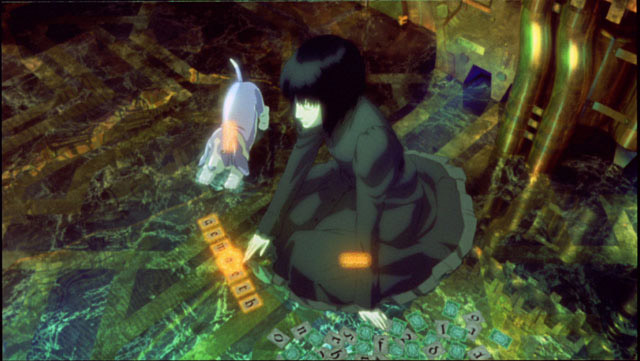
Ghost 2 almost turns the perspective from Ghost one on its head and looks at what it means to be a sentient program and how even humans seeking to become fully cyborg struggle to attain this plateau of ever increasing sensory perception and understanding. Taking Decarte’s notion ("I think, therefore, I am") that sentient life does not require a ghost, Ghost 2 explores the notion that a sentient program or robot (called a "doll") might NOT want to have a ghost, and looks at what happens when ghosts are foisted on dolls. Ideas taken for granted in the real world, like the demarcation between life and death get blended and rendered almost meaningless.
On Dolls: Let’s go into a discussion of dolls for a moment: On one hand, dolls in our terms are purely fake, but in the eyes of a child, are actually "real" in the sense that they are assigned virtual persona and as an object and affect the behavior of the child. In effect, the notion of the child’s mind being constrained to her head is challenged - the child’s mind functions "virtually" in the doll. This notion of a doll is also examined in the sense that it contains our greatest fears - that all we are is a "shell" without something actually unique inside that makes us special. In making a cyborg "doll" that mimics a human - GITS2 poses that we are creating a human-looking shell that is sentient in the Descartes sense, but is not complete. Even worse, when given a facsimile of a ghost, we are doing real harm to the doll as the doll is now neither a stable sentient robot nor a human, but a bastardized thing in-between.
In total, there is this ongoing discussion of three types of "ultimate" life forms: God, Dolls, and animals. They all embody the notion of innocence. God (in this sense, almost synonymous with Major Motoko’s new form) is all knowing so basic human frailties no longer affect her. Needs and desires that humans have are non-existent for God. Dolls, and in cyborg version of dolls - sentient robots, are also perfect in that they can think but don’t fall prey to human inadequacies. Finally, Oshii argues animals such as dogs are innocent. Their joys in life are simple ones - Batou’s dog scenes also serve to demonstrate that which is still "human" about Batou - everything else in his life has been rendered meaningless. In this sense, interestingly the dog takes on the same roll as a doll does with a child - This shows Batou’s mind expressing its "virtual" humanity externally.
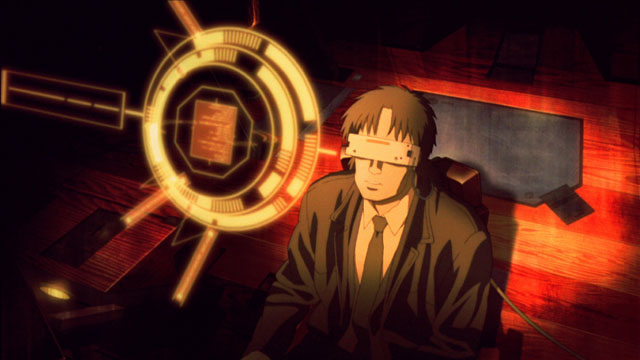
Throughout the movie are instances of humanity’s self-gratification, extreme self-importance and the consequences of over-indulgence. From the enormous cathedrals to the dingy alleyways, to the making of dolls in our own “perfect” shell of ourselves, Oshii’s message is that we are doing everything possible to hide ourselves from true humanity. The beautiful imagery of GITS 2 is the result. Freedom comes not through materialism, but through real “humanity.” However, one wonders whether Oshii thinks real humanity is in anyway restricted to humans. At some level Oshii is saying our bodies are now obsolete, and that what makes us human, our shell, may not be the purview of humans.
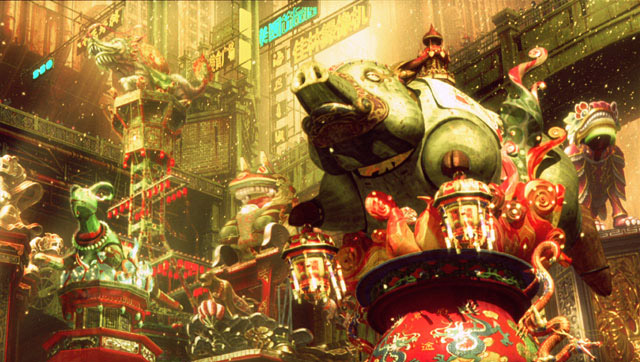
As for the details of the merging of traditional hand drawn animation, there are a few scenes where the Babylon 5-like ships or statues don’t quite fit, but for the most part, the expansive scenes have incredible depth, and the close-ups are as exquisite as a portrait. You are truly missing out on a feat of artistic beauty if pass this movie up. And overall, GITS:2 is clearly in of the best new cyberpunk movies out. Watch it - you won’t be disappointed.
~See movies similar to this one~
Tags: cyberpunk movie review
|














































